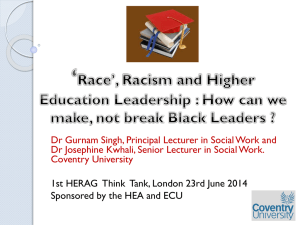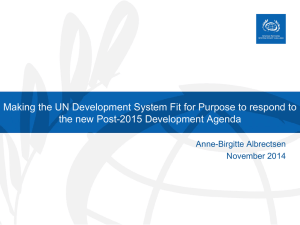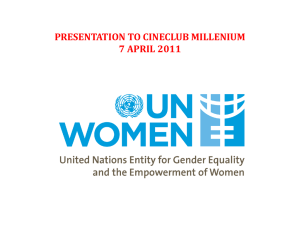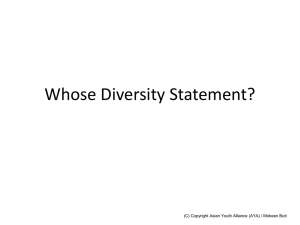3 Presentation John Ryan IVEA
advertisement
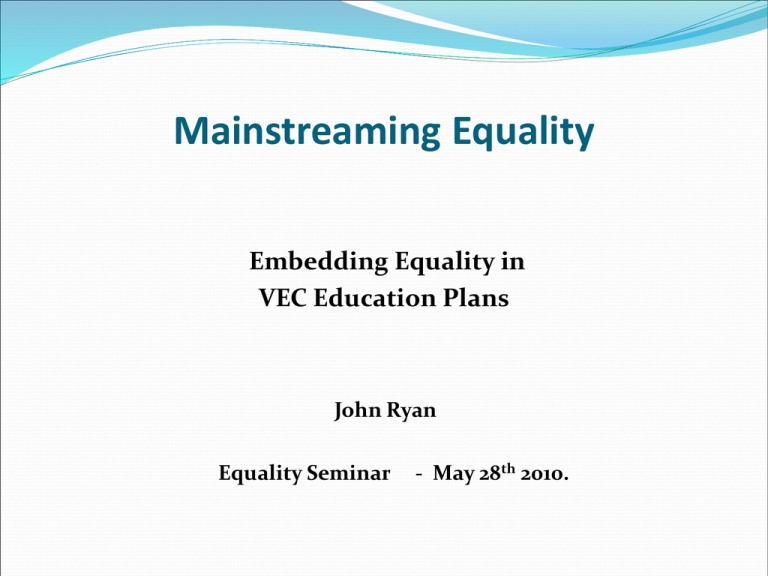
Mainstreaming Equality Embedding Equality in VEC Education Plans John Ryan Equality Seminar - May 28th 2010. Mainstreaming Equality. The goal of equality is to ensure that all services provided by the VEC Sector are available and accessible to all potential participants encompassed by the nine grounds named in the equality acts. Mainstreaming is the process by which this goal is achieved. It goes beyond the legal requirements and places equality at the core of all polices and decision making in each VEC, School, College and centre. Mainstreaming Equality ctd. In this way it embeds equality in the VEC Sector’s plans, policies, programmes and daily business. It considers the core issue of equality at all stages of policy development on disadvantaged groups - research, consultation, implementation and evaluation. Review and evaluation is central to the embedding process. IVEA/VEC Sector Commitments Delivering equality for its workforce and learners is a key priority for the IVEA and the VEC Sector. All staff must be engaged in this process. The Sector is committed to providing accessible services to all in its role as a major provider of education services. IVEA/VEC Sector Commitments ctd. Each VEC endeavours to ensures its employees and its learners are not discriminated against on basis of their: gender, marital status, family status, age, race, religion, disability, sexual orientation or membership of the travelling community. The Sector is committed to accommodating diversity, accommodating people with disabilities and promoting equality for all staff, service users and other stakeholders. Reference: Guidelines for conducting Equality Impact Assessments Embedding Equality in Education Plans The development of its Education Plans for the next five years provide a real opportunity for each VEC to review, evaluate and embed equality in its new Educational Plan, its organisational structures, policies and procedures. Embedding Equality in Education Plans ctd. The development of the plan has a number of important stages for the process of embedding equality - Legislation - Incorporates equality & related acts Vision and Mission Statement – underpins equality and diversity Review of current services – identifies issues to be addressed Consultation process – engages key stakeholders from nine grounds. Outcomes for consideration - includes equality issues Setting goals and objectives - embraces inclusive education Implementation procedures - Embeds equality in all activities. Systems for evaluation and review - Equality Impact Assessment. Key elements of Equality Legislation (1) Employment Equality Acts 1998 & 2004 This covers:Vocational training, advertising, equal pay, access to employment, terms and conditions of employment, promotion, re-grading, dismissal and collective agreements. They apply to:- VECs, full-time, part-time and temporary employees. Key elements of Equality Legislation (1) Disability related requirements:- VECs must take appropriate measures to enable a person who has a disability to have access to employment or to a vocational training course, to participate or advance in employment, or to undertake employment unless the measure would impose a disproportionate burden on the employer or provider of vocational training. Key elements to equality legislation (2) Equal Status Acts 2000 to 2004. Covers all education services provided by VECs. VECs cannot discriminate (some exemptions apply) in relation to - admission or the terms or conditions of admissions the access of any student to any course, facility or benefit any other terms or condition the expulsion of a student or other sanction. Key elements to equality legislation (2) Disability related requirements: Students with a disability must be mainstreamed unless the disability makes it impossible to provide services or has a detrimental effect on other students. VECs must do all that is reasonable possible to provide accommodation for students with disabilities which includes providing special treatment or facilities without which it would be impossible to accommodate the student. Outcomes of the legislation Everyone in VEC has the right to work and learn in an environment that is free from all forms of discrimination, harassment and prejudice. Equality must be a core focus in the business of the VEC. Equality impact assessments are available to monitor the impact of the VEC activities on the needs of individuals and groups across the nine grounds that experience inequality. Everyone has a right to an equal opportunity to participate in, to receive and to benefit from services in accordance with their needs. Outcomes of the legislation ctd. This requires each VEC to combat all forms of discrimination, prejudice, inequality and stereotyping. VECs must provide accessible services in a flexible manner to meet needs of all learners Cultural and other diversities should be acknowledged, valued, celebrated and accommodated including making reasonable accommodation for people with disabilities. Outcomes of Legislation - continued The diverse identities, experiences and situations of different individuals and groups will require adjustments in the design and delivery of plans, policies and programmes to achieve equality by accommodating their various needs. Staff and representatives from groups that experience inequality must be consulted on their needs and how best these needs can be met. VECs should encourage their partner agencies to develop a similar approach to equality and diversity. Vision & Mission Statement The mission statement of an educational organisation is at the heart of the organisation and breathes life into every element of the organisation. It shapes its vision, determines its ethos, creates a working and learning environment that is free from discrimination. It accommodates diversity and is as inclusive and accessible as possible for all concerned. To embed equality in the mission statement all elements of the organisation must be involved in developing and agreeing the statements through consultation and agreement. Vision & Mission Statement ctd. The mission statement must ensure that anyone disadvantaged under any of the nine grounds will have access to education services and/or employment opportunities. An external process of consultation with representatives of those disadvantaged under any of the nine grounds should take place . These representatives should come from bodies and agencies, statutory and voluntary, local and national, including learners, other service users and the community in general. Review of Services & The Consultative Process. This involves the internal consultation with staff and the external consultation with those representing those disadvantaged under any of the nine grounds. In designing the new plan the identity, situation and experience of each of the disadvantaged groups and how they will be accommodated as employees or learners in the VEC need to be considered. All current programmes should be reviewed from an equality viewpoint using the IVEA equality impact assessment guidelines where necessary to ensure that the needs of individuals and groups across the nine grounds are met. Review of Services & The Consultative Process.. The data gathered needs to be analysed and incorporated into the plan so that it accommodates diversity, promotes equality and ensures there is no discrimination on any of the nine grounds. The draft of the plan should then be subject to an equality impact statement. The afternoon session will deal with the consultative process in more detail. The Consultative process – Difference Difference: Each of the groups across the nine grounds have a different identity, experience and situation that must be considered to ensure the education plan takes account of diversity, promotes equality and prevents discrimination. Identity is defined as the particular characteristics, values, beliefs and aspirations held by a group and is an essential component in determining difference. Situation describes the broad status of the group in terms of their standing in areas such as the labour market, education and income Experience describes the relationships between the group and the wider society and how those experiences affects their participation in and outcomes from areas such as education provision. Embedding equality – Objectives for consideration Build equality into the organisational infrastructure Establish equality as a whole organisational issue. Embed equality in all plans, policies and programmes. Produce information in accessible formats. Establish an inclusive educational environment that facilitates a process of growth for staff and students. Ensure all buildings, structures and courses are accessible to staff and students Embedding equality – Objectives for consideration ctd Develop a universal admission policy which accommodates individuals from diverse backgrounds and/or with disabilities. Ensure all courses are accessible to those meeting the entry requirements regardless of age, race etc. Develop strategies to overcome barriers arising from differences of socio-economic status, gender, ethnicity and disability. Develop teaching strategies, curricula, modes of assessments and methods of delivery that accept diversity and cultural differences as the norm. Implementation – evaluation – review. In 2007 The IVEA and the Equality Authority developed guidelines for conducting equality impact assessments on IVEA &VEC plans, policies and programmes. It is suggested that all draft education plans should be subject to an equality impact statement. This process will seek to test whether the plan promotes equality, accommodates diversity and does not discriminate against individuals and groups across the nine grounds of the equality legislation. Implementation – evaluation – review. It requires the participation of the groups and their individual members to ensure the plan does not put the groups at a disadvantage. It ensures that an equality and diversity perspective based on the nine grounds is incorporated into the plan and that equality is embedded in the VEC as an educational organisation meeting the needs of the whole community and society. Programmes and policies should be evaluated on a regular basis to ensure equality remains at the core of the organisation.



